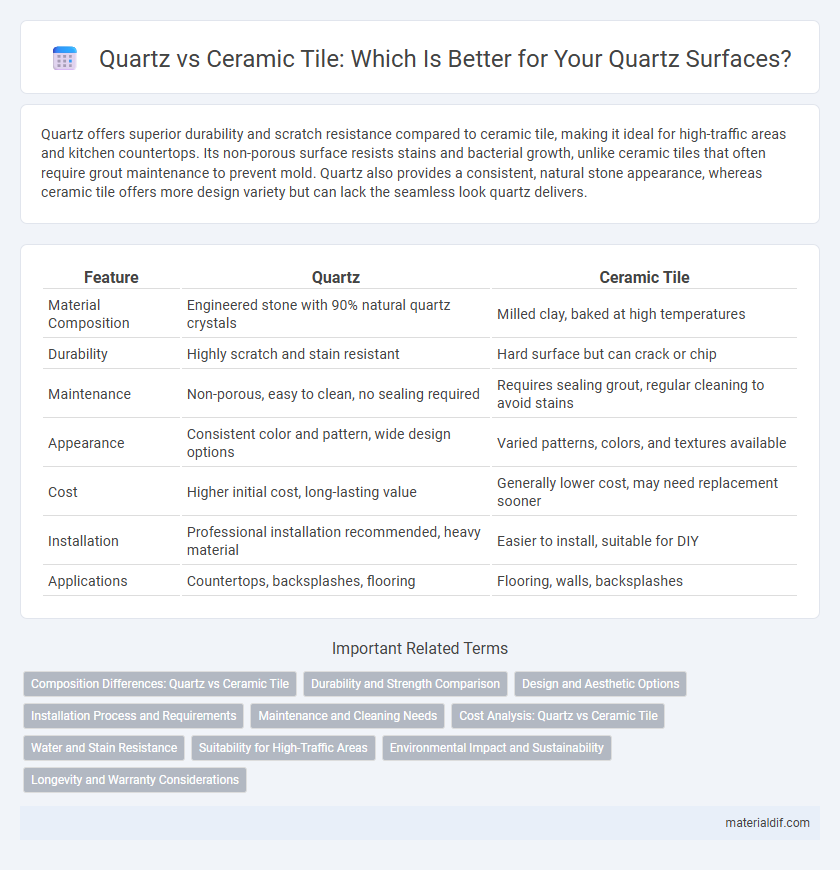Quartz offers superior durability and scratch resistance compared to ceramic tile, making it ideal for high-traffic areas and kitchen countertops. Its non-porous surface resists stains and bacterial growth, unlike ceramic tiles that often require grout maintenance to prevent mold. Quartz also provides a consistent, natural stone appearance, whereas ceramic tile offers more design variety but can lack the seamless look quartz delivers.
Table of Comparison
| Feature | Quartz | Ceramic Tile |
|---|---|---|
| Material Composition | Engineered stone with 90% natural quartz crystals | Milled clay, baked at high temperatures |
| Durability | Highly scratch and stain resistant | Hard surface but can crack or chip |
| Maintenance | Non-porous, easy to clean, no sealing required | Requires sealing grout, regular cleaning to avoid stains |
| Appearance | Consistent color and pattern, wide design options | Varied patterns, colors, and textures available |
| Cost | Higher initial cost, long-lasting value | Generally lower cost, may need replacement sooner |
| Installation | Professional installation recommended, heavy material | Easier to install, suitable for DIY |
| Applications | Countertops, backsplashes, flooring | Flooring, walls, backsplashes |
Composition Differences: Quartz vs Ceramic Tile
Quartz countertops are engineered from natural quartz crystals combined with resin and pigments, creating a durable and non-porous surface. Ceramic tiles consist primarily of clay and other natural materials, fired at high temperatures to achieve hardness and water resistance. The resin in quartz provides flexibility and stain resistance, whereas ceramic tiles rely on their glazed surface for protection but remain more prone to chipping and grout maintenance.
Durability and Strength Comparison
Quartz surfaces exhibit superior durability and strength compared to ceramic tiles due to their non-porous and engineered composition, which resists chipping, cracking, and staining. Quartz countertops typically have a hardness rating of 7 on the Mohs scale, making them more resistant to scratches than ceramic tiles, which usually rank around 6. The density and resin binding in quartz enhance its impact resistance, providing a longer lifespan and better performance in high-traffic areas than ceramic tile surfaces.
Design and Aesthetic Options
Quartz offers a broader range of design and aesthetic options compared to ceramic tile, featuring consistent patterns and vibrant colors achieved through engineered manufacturing processes. Its non-porous surface allows for high-gloss and matte finishes that mimic natural stones such as marble and granite, providing a luxurious appearance. Ceramic tiles, while available in various shapes and styles, typically display more limited pattern uniformity and color depth due to their natural clay composition and glazing techniques.
Installation Process and Requirements
Quartz countertops require professional installation due to their heavy weight and the need for precise cutting with specialized tools, often involving adhesives and mechanical fasteners for secure placement. Ceramic tile installation demands thorough surface preparation, including waterproofing and leveling, followed by setting tiles with mortar and grout, which allows for DIY options but still requires skill for even spacing and alignment. Both materials necessitate proper subfloor or countertop support to prevent cracking, but quartz installation is generally more labor-intensive and costly.
Maintenance and Cleaning Needs
Quartz surfaces require minimal maintenance, needing only regular wiping with mild soap and water to maintain their non-porous, stain-resistant quality. Ceramic tiles demand more frequent grout cleaning and sealing to prevent mold and staining due to their porous grout lines. Quartz's durability and resistance to chemicals make it a more convenient option for long-term upkeep compared to ceramic tile.
Cost Analysis: Quartz vs Ceramic Tile
Quartz countertops typically cost between $50 and $100 per square foot, making them a premium option compared to ceramic tile, which generally ranges from $5 to $15 per square foot. Installation expenses for quartz are higher due to its heavy weight and the need for professional handling, whereas ceramic tile installation can be more affordable and occasionally done by skilled DIY homeowners. Long-term maintenance costs for quartz are lower since it is non-porous and resistant to stains, while ceramic tile may require periodic grout sealing to prevent damage and maintain appearance.
Water and Stain Resistance
Quartz surfaces offer superior water and stain resistance compared to ceramic tiles, due to their non-porous composition and resin binding that prevents liquid absorption. Ceramic tiles, although water-resistant, often have grout lines which can absorb moisture and stains, making maintenance more challenging. Quartz's dense and smooth surface ensures easier cleaning and higher durability against common household stains and water damage.
Suitability for High-Traffic Areas
Quartz surfaces exhibit exceptional durability and resistance to scratches and stains, making them highly suitable for high-traffic areas such as commercial spaces and busy kitchens. Unlike ceramic tile, which can chip or crack under heavy impact, quartz maintains its structural integrity and appearance over time with minimal maintenance. The non-porous nature of quartz also prevents moisture absorption, enhancing its resilience in environments subjected to frequent use and spills.
Environmental Impact and Sustainability
Quartz surfaces are engineered using natural quartz combined with resins and pigments, resulting in durable countertops with moderate environmental impact due to energy-intensive manufacturing and limited recyclability. Ceramic tiles derive from abundant natural clay and minerals, often fired at high temperatures, which consumes significant energy but offers greater recyclability and lower emissions over its lifecycle. Sustainable choices favor ceramic tiles for their natural composition and recyclability, whereas quartz requires careful sourcing and disposal considerations to mitigate environmental effects.
Longevity and Warranty Considerations
Quartz surfaces typically offer superior longevity compared to ceramic tile due to their engineered composition, which enhances durability and resistance to chipping and cracking. Warranty considerations for quartz often include extended coverage, sometimes up to 15-25 years, reflecting their robust performance in high-traffic or kitchen environments. Ceramic tile warranties generally cover 10-15 years but may not account for issues like grout discoloration or tile cracking under heavy impact.
Quartz vs Ceramic Tile Infographic

 materialdif.com
materialdif.com